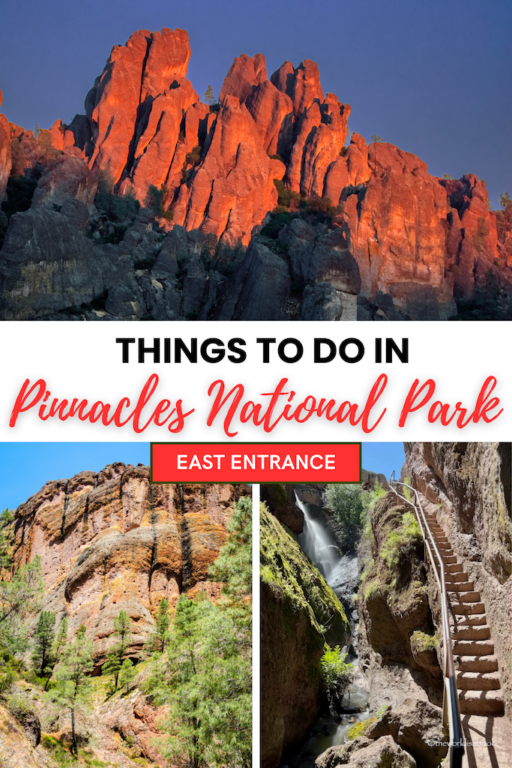As California residents, it is only fitting to cross off the Golden State’s National Parks off our travel list. I have wanted to visit our state’s newest national park for awhile now and glad we finally visited on a beautiful Spring day last year. If you have a limited time, this was our one day itinerary and things to do at Pinnacles National Park – East Side.
Nestled in central California, this park offers stunning landscapes, incredible hiking trails and a chance to see some of the state’s rare wildlife. Here’s our first-hand guide to help you make the most of your visit using the east entrance of Pinnacles National Park.
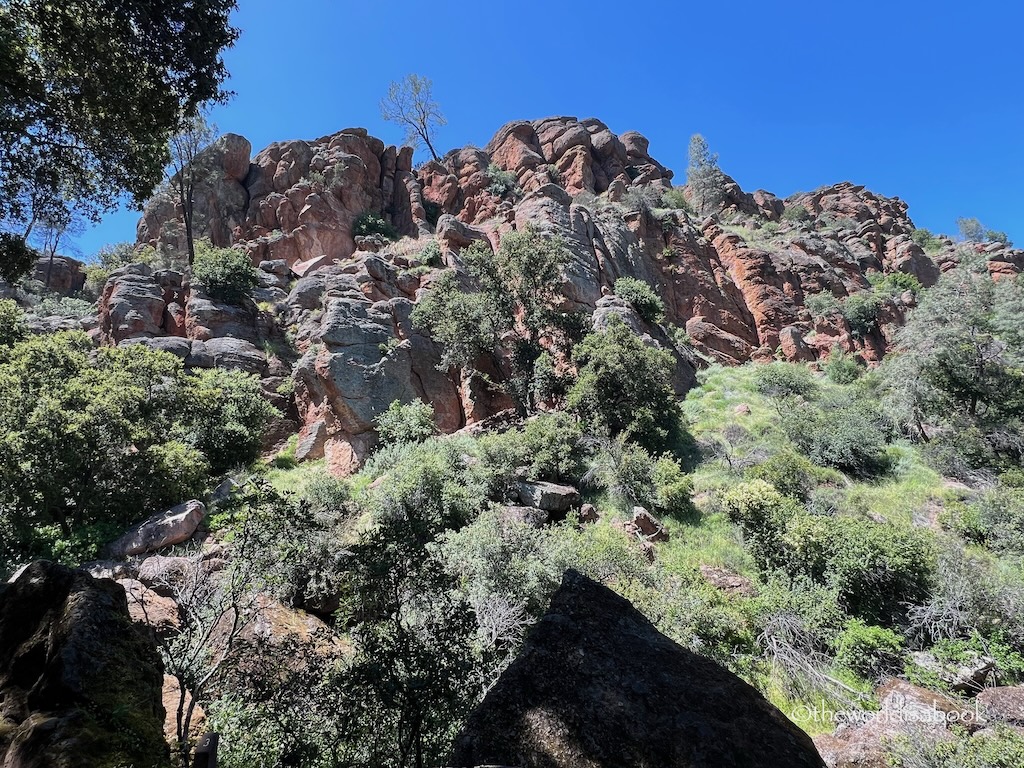
History of Pinnacles National Park
Pinnacles National Park has a rich history shaped by both geological forces and human influence. Volcanic activity created the dramatic rock formations that define the park. Indigenous peoples lived in the area for thousands of years. They were drawn to the unique landscapes and relied on harvesting native plants and hunting wild animals.
Much like many of the native people in California at that time, the Spaniards came to colonize them. They also brought diseases that decimated their population in the late 1700s and early 1800s. Unfortunately, the survivors were forced to convert to Christianity and had to live in the missions.
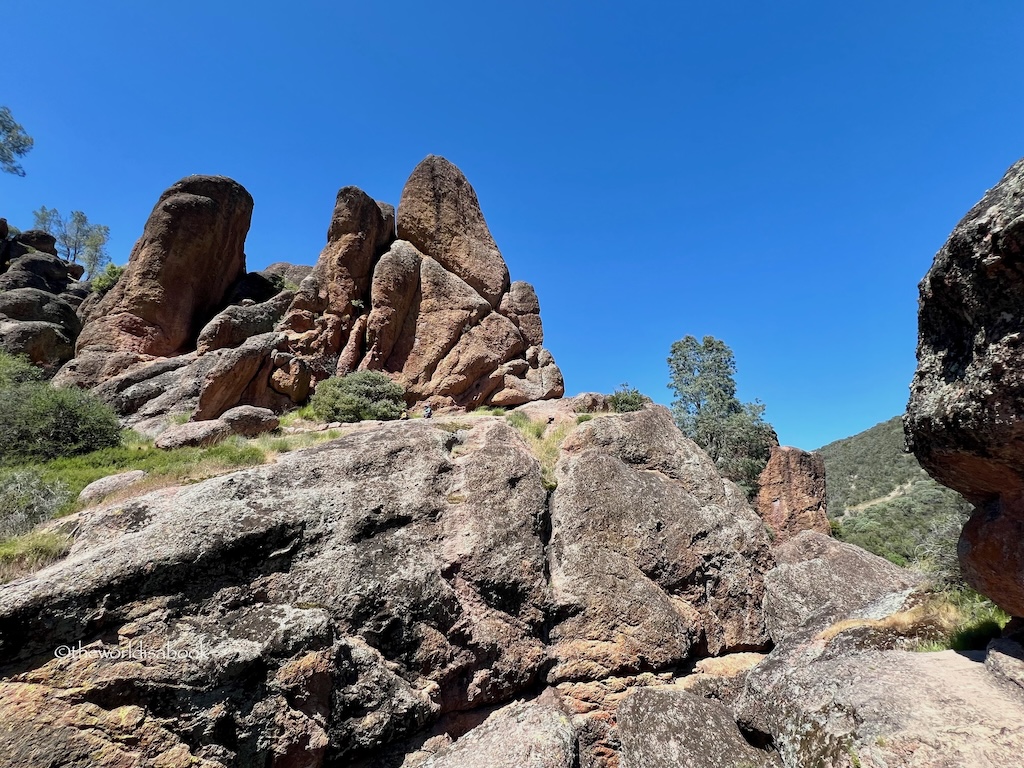
Homesteaders came in the late 1800s to build farms in the area. One of those settlers, Schuyler Hain, was instrumental in protecting the area that eventually led to President Theodore Roosevelt designating it as a national monument in 1908.
It was upgraded to a national park in 2013 and one of the newest in the system. It’s also still one of the least visited parks in the country.
Getting to Pinnacles National Park East Entrance
Pinnacles National Park is about two hours south of San Jose. The park has two main entrances: East and West. They are not connected by roads but hiking between the two is possible through three miles (4.8 km) of trails. So, plan your route accordingly depending on your location and preferences.
The East Entrance offers more amenities, including the park’s only campground. This entrance is also open 24 hours. The West Entrance provides quicker access to some popular trails and usually only open from 8AM to 8PM.
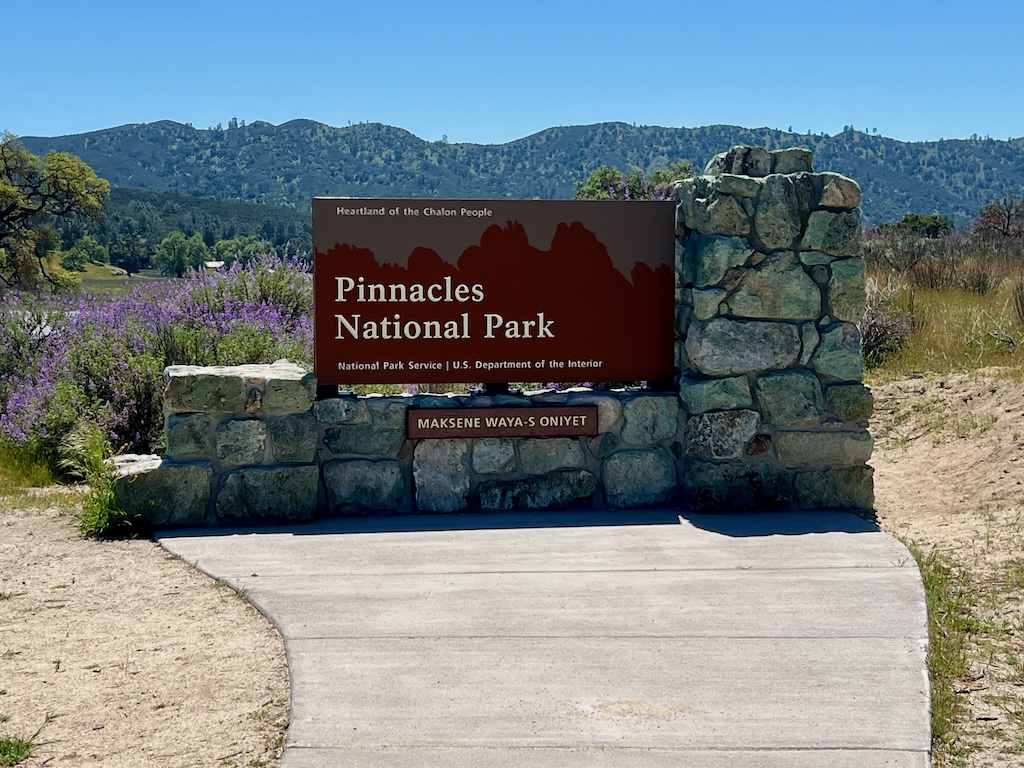
We were visiting the San Jose/Silicon Valley area so we entered through the East entrance. I wished we could have done the two sides but we were short on time.
And we would have to drive 60 miles between the two entrances. It’s another reason for us to return to Pinnacles and explore more of the western part of the park next time.
When to go to Pinnacles National Park
While the central California area usually has ideal weather, there are some things to consider on deciding when to visit Pinnacles National Park. Spring and Fall are considered the best times to visit.
The weather is mild, and the wildflowers are in bloom especially during Spring. Summer can be brutally hot, while winter sometimes brings rain and cooler temperatures. We enjoyed our April visit with fair weather, no rain and less people.
Things to do in Pinnacles National Park East
Hiking Trails
Hiking is the main attraction at Pinnacles. There are over 30 scenic trails throughout the park. Here are some trails you shouldn’t miss:
- Bear Gulch Cave Trail: This two-mile roundtrip trail (on the East side) is a favorite, taking you through talus caves and ending at a beautiful reservoir.
- High Peaks Trail: For those seeking a challenge, this trail offers steep climbs and breathtaking views. It’s not for the faint of heart, but the panoramic scenery at the top is worth it.
- Balconies Cave Trail: This loop (on the West side) offers a mix of climbing and scenic vistas and includes the Balconies Cave.
Here are more trails and their distances on Pinnacles National Park’s website.
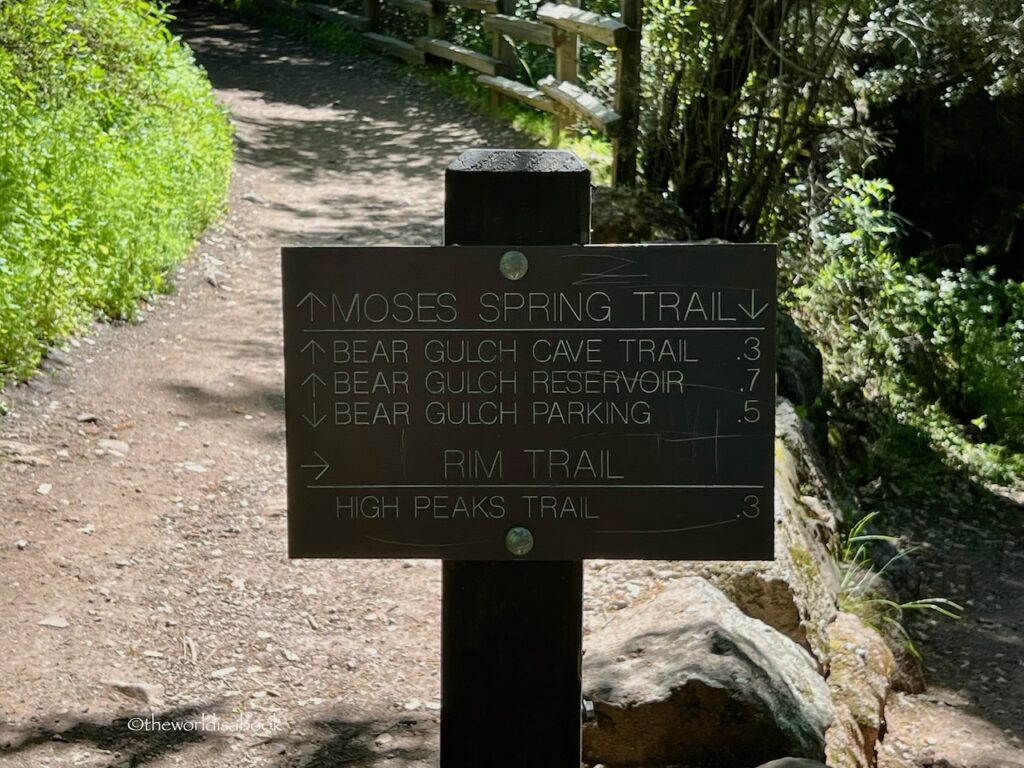
Doing the Bear Gulch Cave Trail
We did the Moses Spring Trail and Bear Gulch Cave Trail which is a two-mile roundtrip hike that ended at Bear Gulch reservoir and through the Lower Bear Gulch Caves. We were only at the park during the afternoon so we wanted a short and not too strenuous trail. But, we also wanted to see some highlights of the park.
Parking spaces were limited at the start of the trail through the Bear Gulch parking lot (by the Bear Gulch Nature Center) or the Moses Spring parking area. I can see how crowded this may get during weekends and holidays with not that many parking spots available. There were some restrooms in this area so definitely use them before going on the trails.
The start of the trail was a small uphill area going to High Peaks Trail and then we followed the Moses Spring Trail towards the Bear Gulch Cave Trail. There were some signage for the trails so it’s hard to get lost.
Along the way, we saw massive rock formations and the pinnacles which are the namesake of the park. We also saw many mosses and ferns. The entrance to Bear Gulch Cave is marked with a sign and a boulder that looked like it got stuck along with a small spring to the side.
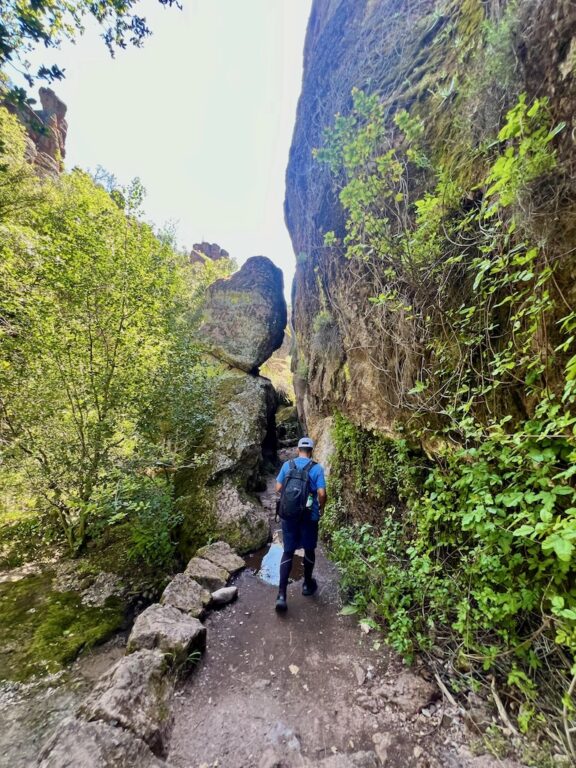
We’ve visited several caves over the years, including the popular Carlsbad Caverns National Park, but this was definitely one of the more unique and memorable ones. The entrance into the caves required some maneuvering and balancing on rocks along the steadily flowing stream.
Bear Gulch Cave Lower Section
The Bear Gulch Caves have two separate sections. We hiked and entered the lower section and this is usually open year round.
The upper section was closed during our visit. This section is only open during certain parts of the year to protect unique species that live here year round. Cooler temperatures and running water that sometimes run through it are ideal living conditions.
Bat colonies, including the Townsend Big Ear Bats, are the primary residents. So, be sure to check the NPS site if you want to explore the two cave sections.
What is a Talus Cave?
This particular cave system is called a talus cave. So, what is a talus cave? This is the first time we’ve actually heard of it.
Talus or boulder caves are formed through the movement of fallen cliff rocks from erosion and tectonic force movements. When a single or large boulder rocks fall from cliffs, they can get stuck and wedged in narrow canyons.
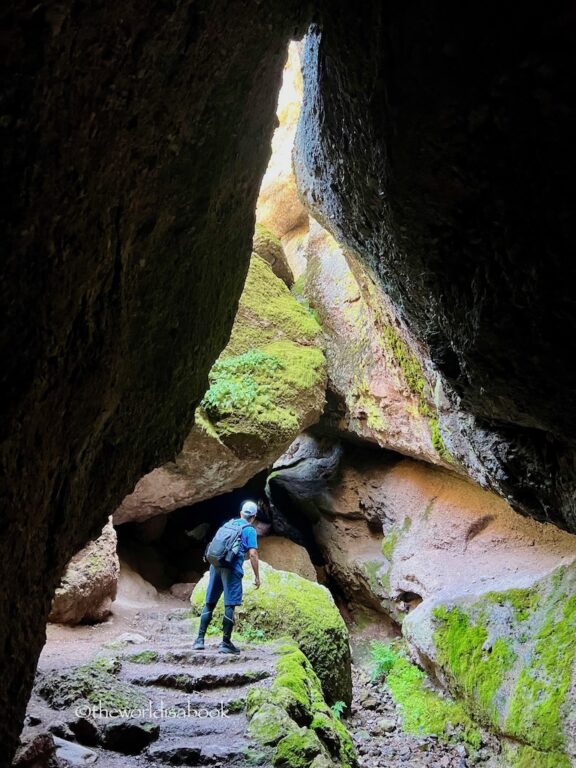
The falling rocks move and settle in places almost glued together by sand and gravel over time and create cave pathways between the boulders. There were two talus cave systems at Pinnacles National Park – Bear Gulch (on the east side) and Balconies Cave (on the west side).
The large boulder wedges form “a series of interconnected voids or rooms” within the caves. This was the majority of the Bear Gulch Cave trail we saw.
We found many of these dark “rooms” as we followed the trails and stone stairs throughout the cave. The Civilian Conservation Corps built these trails and stair systems in the 1930s which made navigating through this cave and trail possible. It was hard not to appreciate all the work and effort it took to build these stairs through this cave.
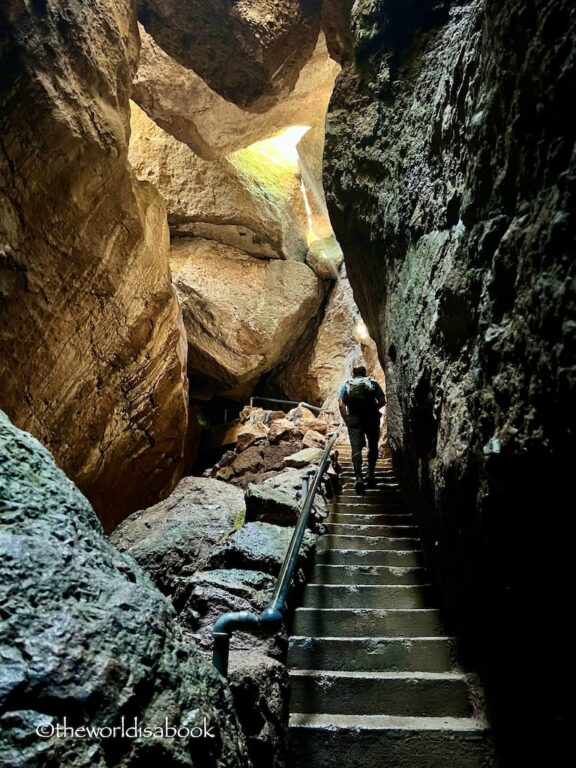
Darkness and Waterfalls inside the Cave
There were several parts of the cave that were almost completely dark. We forgot to bring flashlights and headlamps like we initially planned. So, our two smart phone “flashlight apps” worked as well as it could and helped guide us through the cave.
Be aware that some areas can get quite tight with low ceilings. We did have to scramble over and leaned down on some spots. This cave isn’t for people nervous around the dark or small and tight spaces.
There was also a steady stream in some parts of the cave. Some areas can become flooded depending on the amount of rainfall. We did find some small pathways to avoid stepping into the water but required some balancing acts.
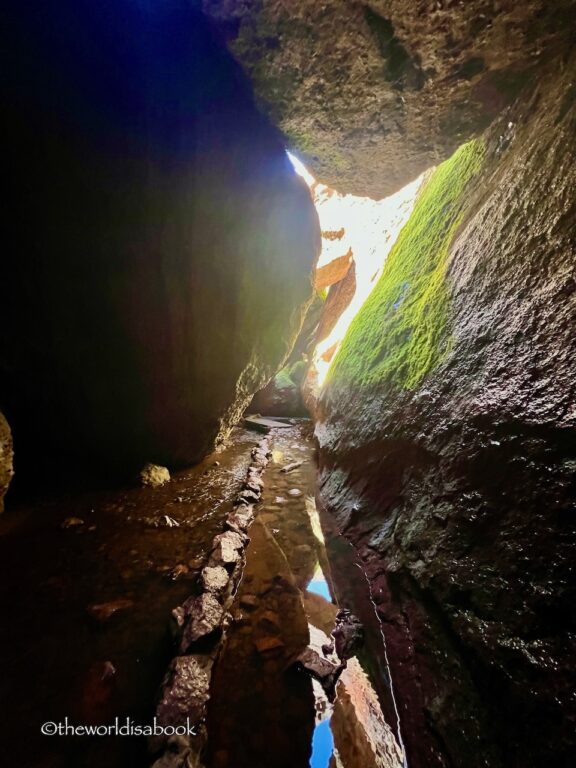
Prepare to get wet or walk carefully through these stepping stones. Some parts may require some wading through if the water level gets higher.
We got lucky it wasn’t very high and we were able to avoid getting our feet soaked. It made for a fun trek into the cave. Check out my husband expertly maneuvering this area to show me where to go.
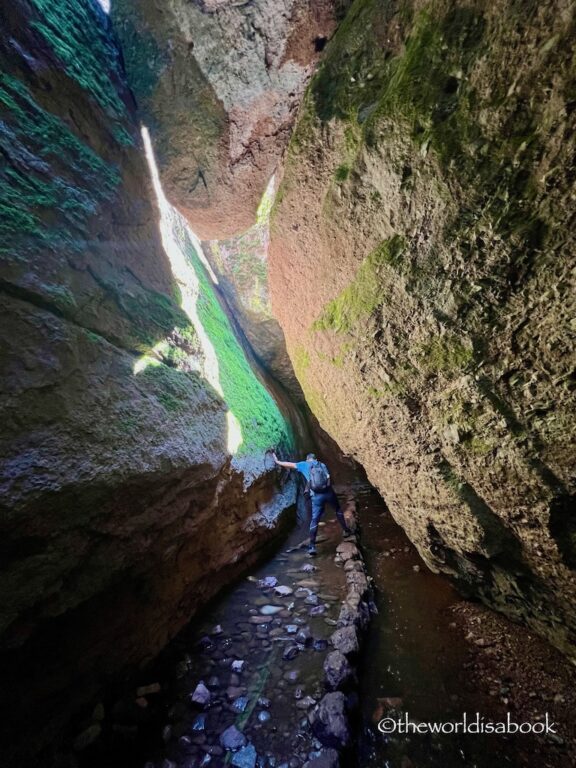
It was quite wonderful to see and hear some waterfalls while inside the cave. Another benefit to coming here after some rainfall. We followed the trail through stone steps that eventually led us outside of the cave.
We emerged out of the cave into a small waterfall and a narrow staircase next to a giant rock. Since we were here during Spring, the water was flowing quite nicely.
I’m not sure how this looks in September after a dry summer. The stairs can become congested (as we found out) when there was some two way traffic because it was quite narrow.
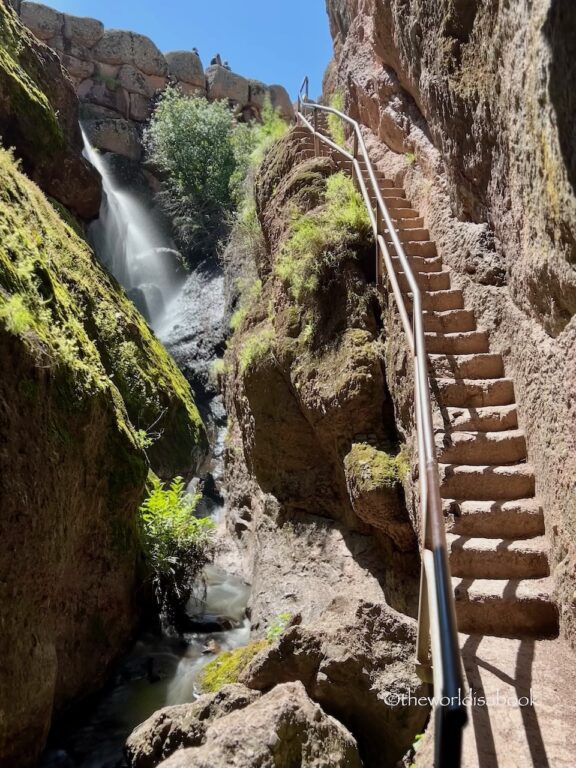
Bear Gulch Reservoir
The stairway led us to the top of the small waterfall and into the Bear Gulch Reservoir. The small body of water was surrounded by many rocks ideal for resting and even some picnics. We spent about an hour here relaxing and trying to look for wildlife without much luck.
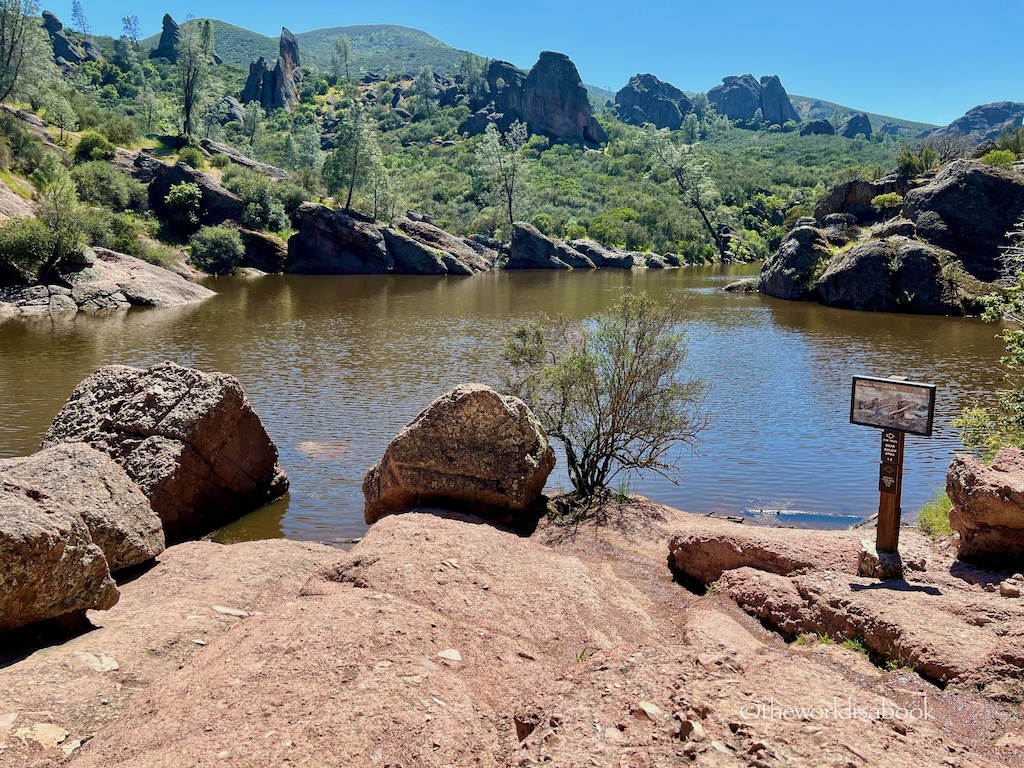
One of the reasons I wanted to do this particular trail was to also see the Bear Gulch Reservoir. Our reality wasn’t the crystal clear water that some had posted on social media pictures. The reservoir was filled with a dark, murky brown water.
This small reservoir was created by a dam. The Civilian Conservation Corps completed this in 1935 to prevent some flooding. Today, it is a popular spot for visitors to watch the sunrise and sunsets and for picnics and rest between hikes.
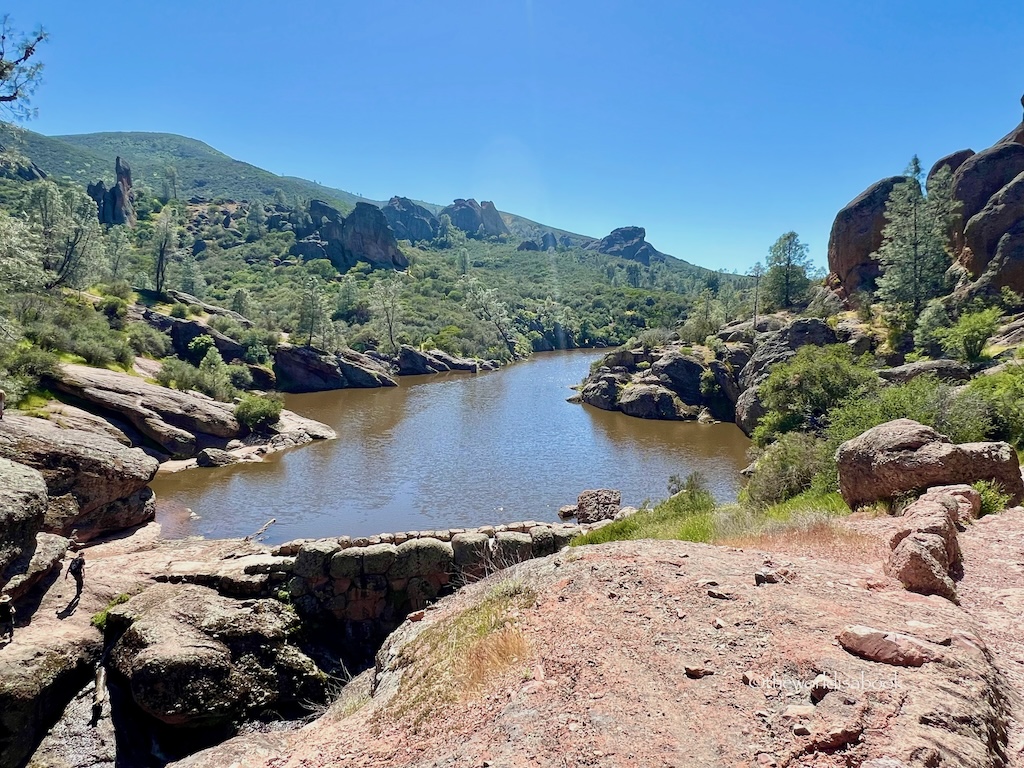
Follow a small trailhead (I believe it’s part of the Rim Trail) that leads to some views of the reservoir from above. We walked a small part of this trail and found these beautiful views too.
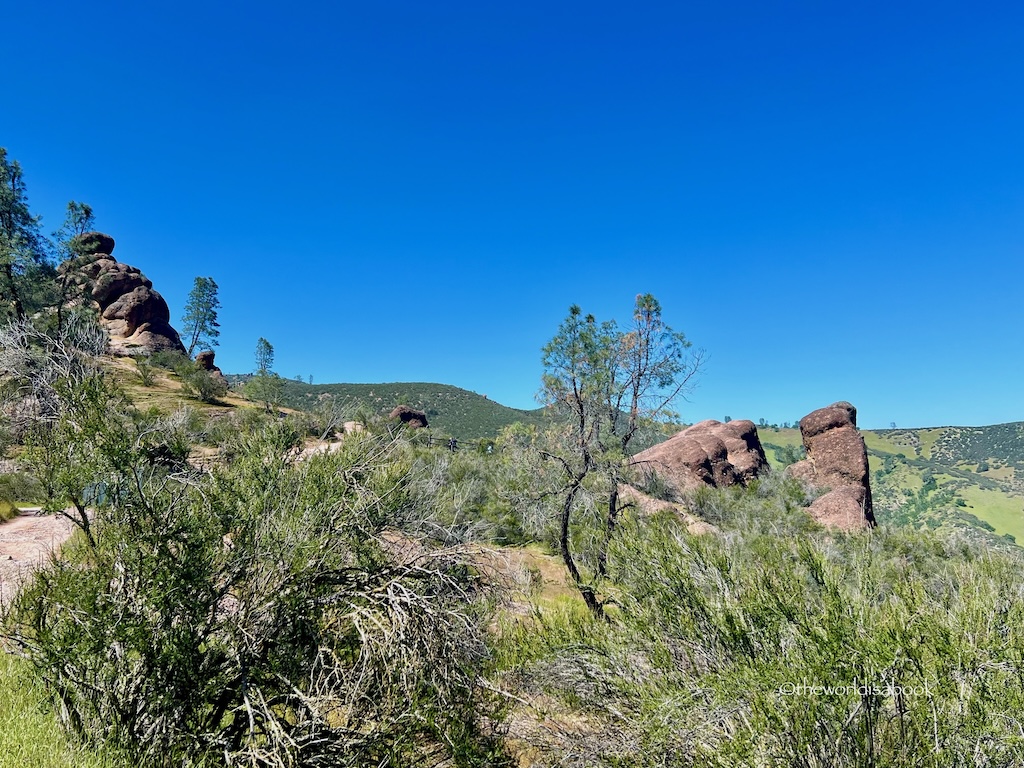
Other Things to do at Pinnacles National Park besides Hiking
While we spent a majority of our time at the park hiking and exploring the cave, there are other unique activities here if you have more time. Here are some we hope to try during our next visit.
Rock Climbing
Pinnacles National Park is a climber’s paradise due to its unique rock formations. There are various climbing routes for all skill levels. Check conditions, general information and regulations before climbing on the park website.
Wildlife Viewing/Birding
Keep an eye out for the endangered California condors (the largest birds in North America). Pinnacles National Park is one of the few places where these magnificent birds can be seen. Early morning or late afternoon are the best times for wildlife spotting.
We came prepared and even brought our binoculars. But, it wasn’t our day to spot a California condor. We looked up a lot and were excited at every bird we saw.
The good thing about trying to to find those California condors was it gave us the chance to look closely at every bird. It was something we most likely would not have done. Apparently, there are over 180 species of birds at this park.
Some other animals we kept an open eye for were the following:
- Gabilan Mountains slender salamander
- Blainville’s horned lizard
- California quail
- Coyote
Unfortunately, we didn’t see any of these animals which were prominently displayed on the park’s pamphlet. Maybe we’ll need to return during sunset next time.
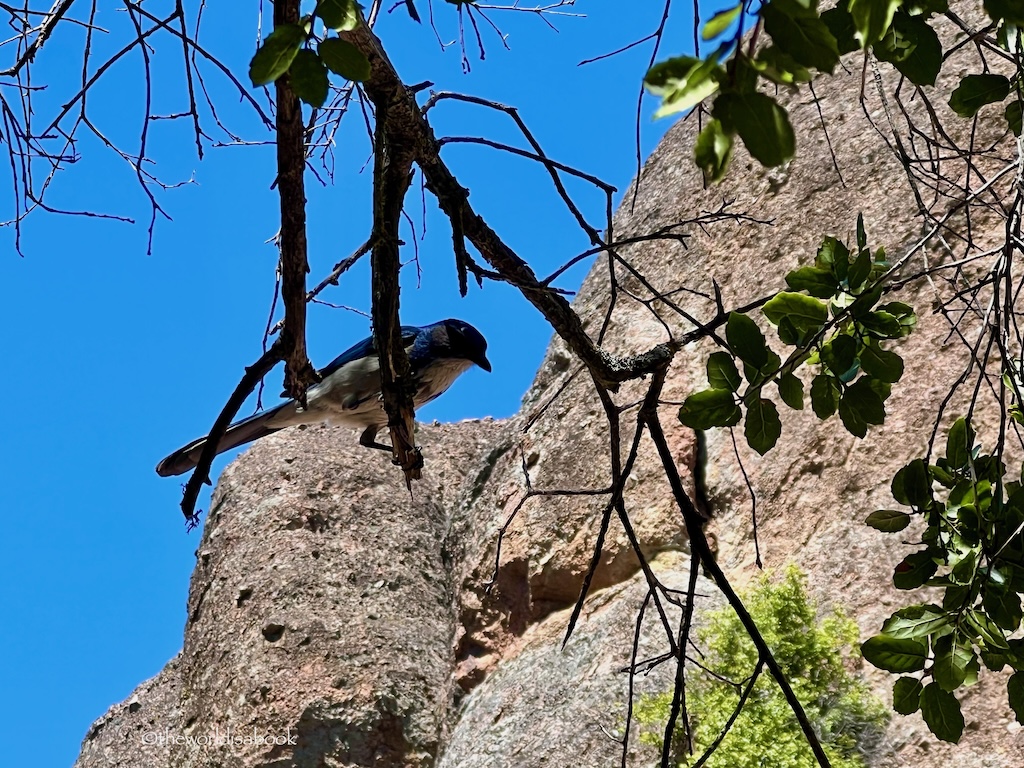
Stargazing
The park’s remote location makes it perfect for stargazing. Bring a blanket, lay back, and enjoy the night sky free from city lights. Remember, this activity will usually have to be on the East side of the park which is open 24 hours.
Tips for Visiting Pinnacles National Park
Plan Ahead
- Reservations: If you’re planning to camp, make reservations well in advance. The campground at the East Entrance (the only one available) fills up quickly, especially during peak seasons and weekends.
- Permits: Some activities, like rock climbing in certain areas, may require permits. Check the park’s website for up-to-date information.
Pack Smart
- Water and Snacks: There are limited services within the park. So, bring plenty of water and snacks. Hydration is key, especially if you’re hiking during the summer months. It is recommended to carry and drink at least one liter of water per person per hour. There is a park store near the campgrounds by the East Entrance for some provisions.
- Clothing: Wear layers always. Mornings and evenings can be cool, while midday temperatures may soar. It was also a bit cooler in the cave doing our visit. Good hiking boots are a must.
- Safety Gear: Don’t be like us! Bring flashlights or head lamps for cave exploration. Cell service is spotty, so don’t rely on your phone’s GPS and bring a map of the park.
Respect the Environment
- Leave No Trace: Pack out all trash and leave nature as you found it.
- Stay on Trails: Protect the delicate ecosystems by sticking to designated paths.
- Wildlife: Observe animals from a distance. Don’t feed them or attempt to touch them.
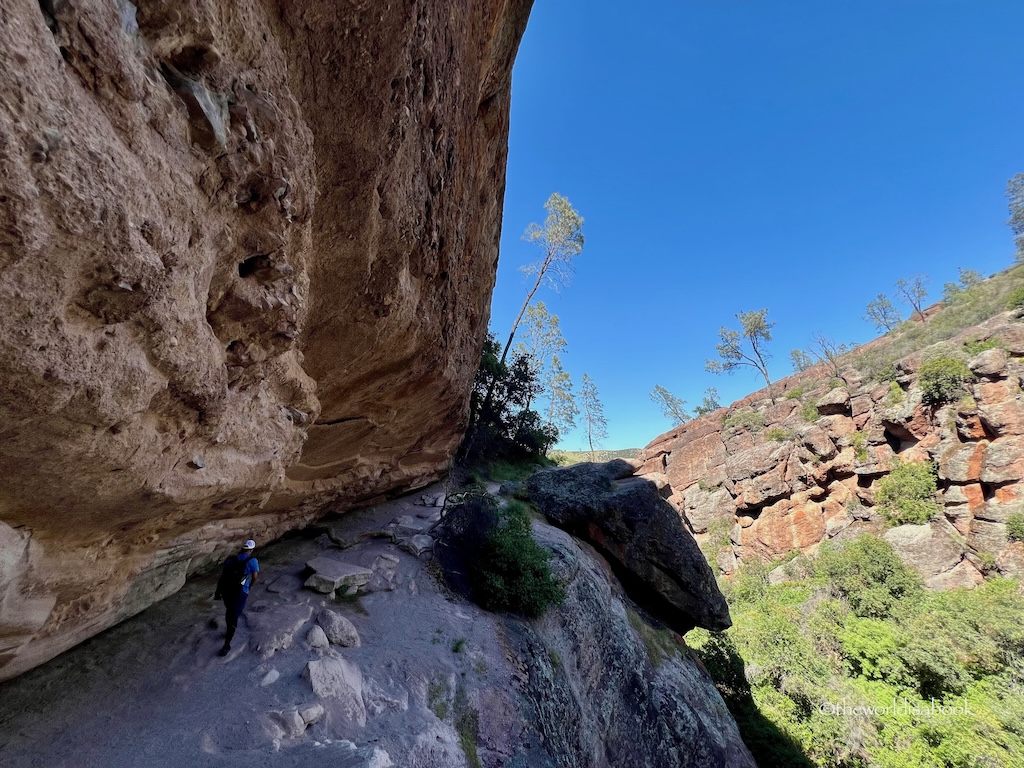
Making the Most of Your Visit
Start Early
Beat the crowds and the heat by starting your hikes early in the morning. This also increases your chances of spotting wildlife.
Join a Ranger Program
Rangers offer guided tours and educational programs at many national parks. These are great for learning more about the park’s history, geology, and wildlife. We’ve always enjoyed talking to rangers during our many national park visits over the years.
Get your park stamps and souvenirs at the Pinnacles park store by the campground on the east side. There is also a visitor station on the west side but may be closed during the low season.
Check the Bear Gulch Nature Center (east side) to talk to park rangers or watch the park film. If you’re traveling with kids, don’t forget to do the Junior Rangers activities to earn a badge. You can get the booklet here too.
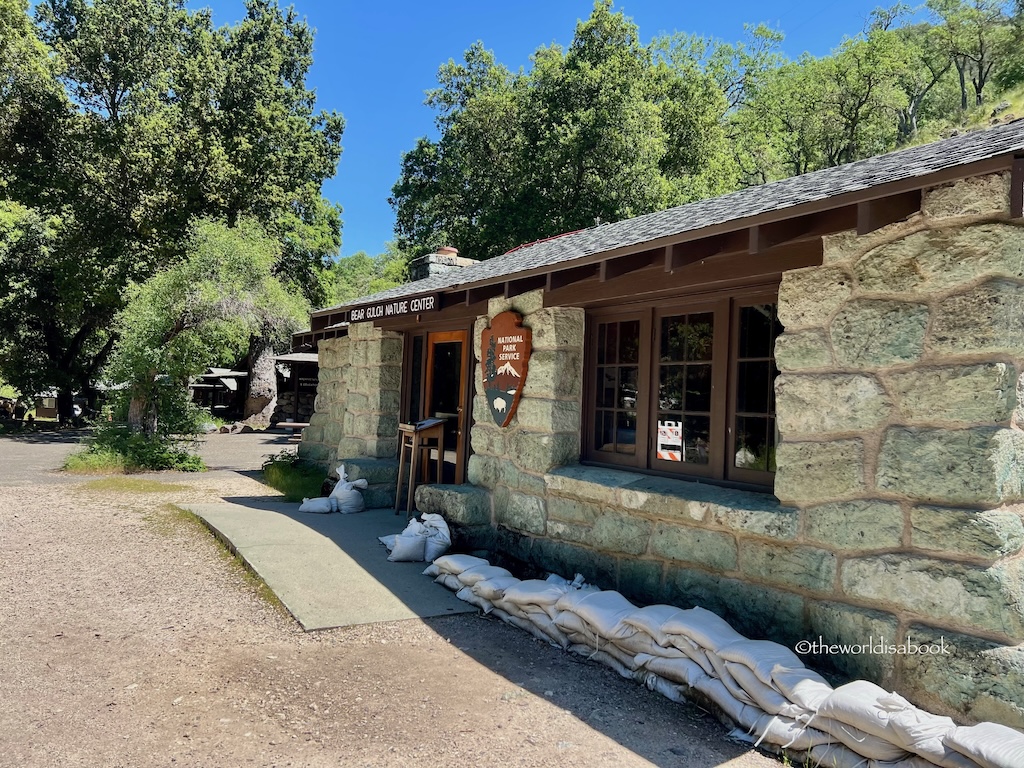
Explore Both Entrances
Each side of the park offers unique experiences. If time allows, explore both the East and West Entrances. The East Entrance has the only campground and the Bear Gulch Cave Trail, while the West Entrance gives quicker access to the High Peaks Trail and a chance to explore the Balconies Cave.
Dining and Accommodation Options
Camping
There are no hotels/motels inside the park. But, the Pinnacles Campground at the east side is your best option for staying overnight especially if you plan to do some stargazing. It offers tent cabins, campsites and RV sites with electric hookups and a small campground store.
There is also a pool that’s open from April to September. Reservations must be made in advance through recreation.gov.
Nearby Towns
If camping isn’t your style (like me), consider staying in nearby towns like Hollister or Soledad. Both offer a range of accommodations and dining options.
- Hollister: About 45 minutes from the East Entrance, Hollister has several hotels and restaurants. It’s a good base if you’re exploring the park for multiple days.
- Soledad: Closer to the West Entrance, Soledad also has a variety of lodging and dining choices. You can also visit the Mission Nuestra Señora de la Soledad here. There are several nearby vineyards, so it’s easy to pair a park trip with some wine tasting.
Final Thoughts
Pinnacles National Park may not be as famous as Yosemite or Sequoia, but it is a hidden gem that offers unique experiences for every adventurer and park lover. Whether you’re an avid hiker, a passionate climber or birder, or just someone looking to escape into nature from the nearby cities, Pinnacles offers rugged landscapes and serene spots.
Pin it for later!
